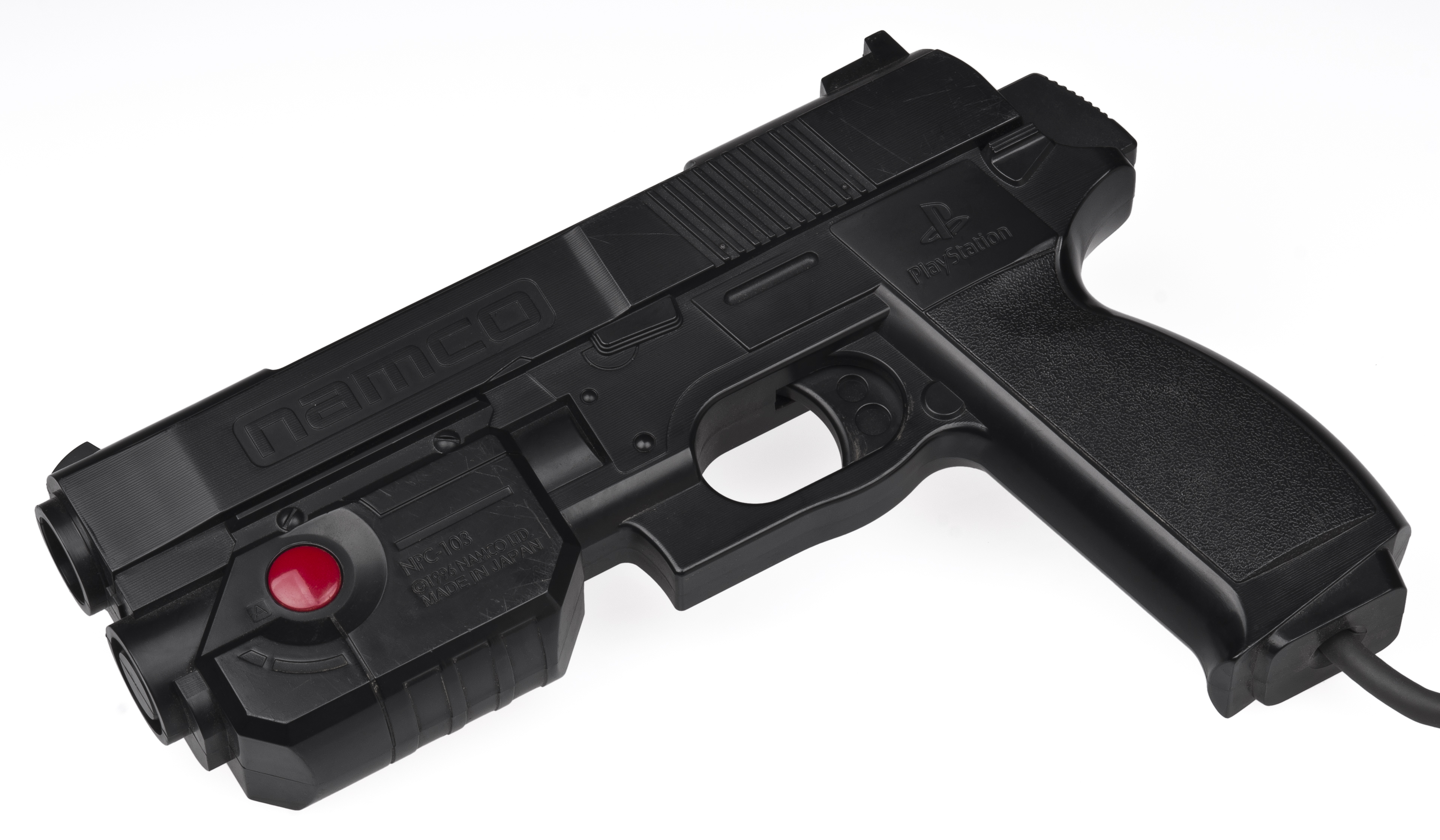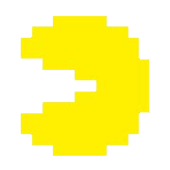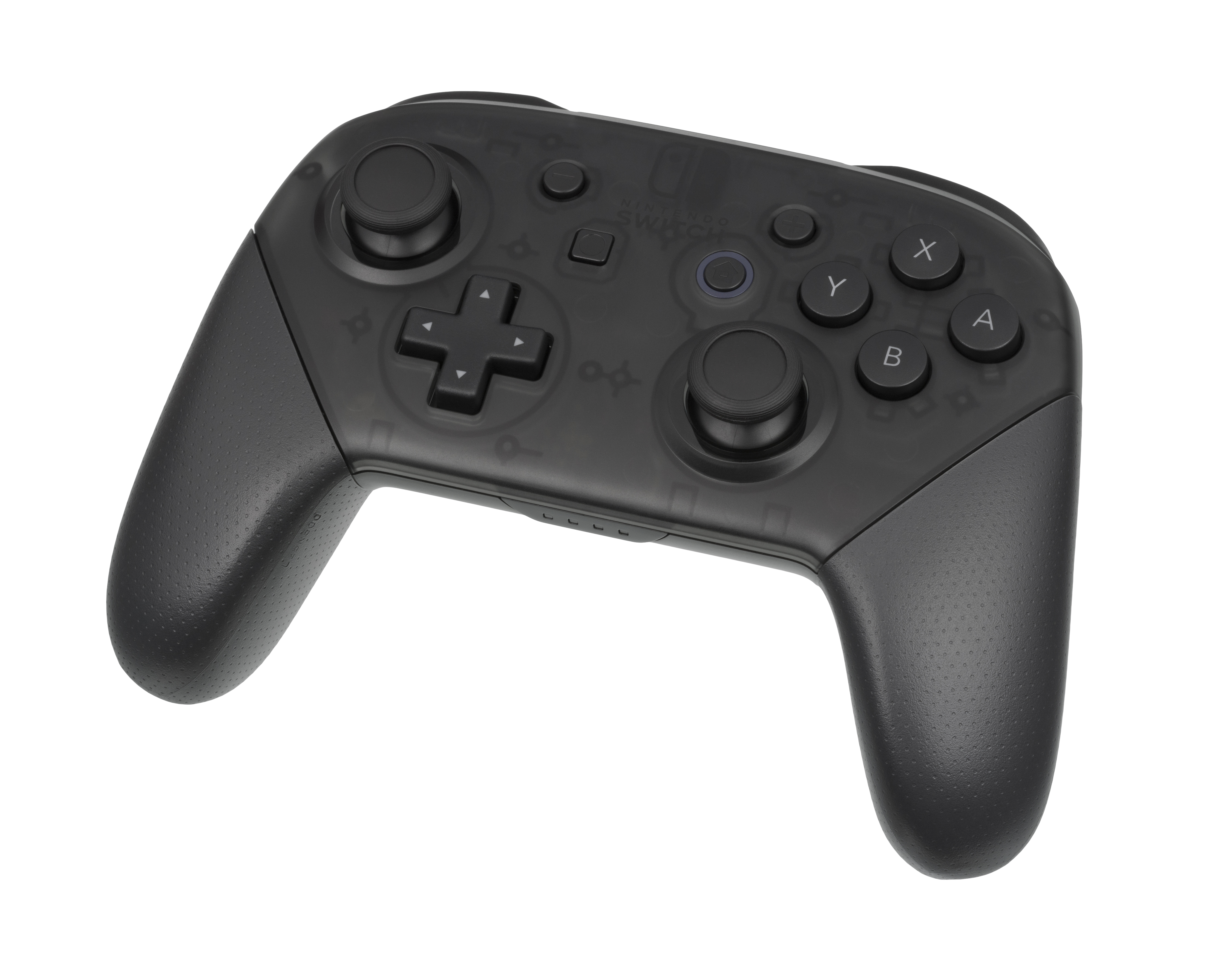|
NeGcon
The , stylized as neGcon, is a motion-based video game controller manufactured in 1995 by Namco for the PlayStation. One of the first third-party peripherals for the system, the controller is connected by a swivel joint, allowing the player to twist the halves relative to each other. The controller also replaces the "symbol" buttons on the original PlayStation controller with two "A" and "B" buttons, as well as "I" and "II" buttons that allowed for analogue control. A black variant was released exclusively in Japan. The NeGcon was created to replicate the analog-stick movement used in the arcade game ''Cyber Sled'' (1993); the name comes from the Japanese word "nejiru", meaning "to twist". The controller was intended for use in racing games, including ''Ridge Racer'', '' Gran Turismo'' and '' Wipeout''. Critical reception for the NeGcon was highly positive, being praised for its responsive control in games and unique design. Description The NeGcon is a video game peripheral releas ... [...More Info...] [...Related Items...] OR: [Wikipedia] [Google] [Baidu] |
Wipeout (video Game)
''Wipeout'' (stylised as ''wipE′out″'') is a futuristic racing video game developed and published by Psygnosis. It is the first game in the ''Wipeout'' series. It was originally released in 1995 for PlayStation and DOS, and in 1996 for Sega Saturn, being a launch title for the PlayStation in Europe. It was re-released as a downloadable game for the PlayStation 3 and PlayStation Portable via the PlayStation Network in 2007. Set in 2052, players compete in the F3600 anti-gravity racing league, piloting one of a selection of craft in races on several tracks around the world. Unique at the time, ''Wipeout'' was noted for its futuristic setting, weapons designed to both stall and destroy enemy opponents and its marketing campaign designed by Keith Hopwood and The Designers Republic. The game features original music from CoLD SToRAGE, with tracks by Leftfield, The Chemical Brothers and Orbital appearing on some versions. The game was critically acclaimed on release; critics pr ... [...More Info...] [...Related Items...] OR: [Wikipedia] [Google] [Baidu] |
Ridge Racer (1993 Video Game)
is a 1993 racing video game developed and published by Namco. It was released initially on the Namco System 22 arcade system board and ported to the PlayStation (console), PlayStation console in 1994. It is the first title in the Ridge Racer, ''Ridge Racer'' series released for arcade game, arcades and home consoles. The aim is to finish in first place in a series of races. The PlayStation version supports Namco's NeGcon controller. Development took eight months, and the game is based on a trend among Japanese car enthusiasts, which involves racing on mountain roads while Drifting (motorsport), drifting around corners. It was also the first arcade video game with 3D texture-mapped graphics, with its System 22 hardware capable of texture mapping and Gouraud shading. The first home version was released in Japan in 1994 as a Launch game, launch title for the PlayStation; the versions for North America and Europe were released in 1995, also as a launch title for both regions. It w ... [...More Info...] [...Related Items...] OR: [Wikipedia] [Google] [Baidu] |
V-Rally (video Game)
''V-Rally'' is a racing video game developed by Infogrames Multimedia and released for the PlayStation console in 1997. The first game in the ''V-Rally'' series, it is based on the 1997 and 1998 World Rally Championship seasons, and features officially licensed cars and tracks inspired by real locations of rally events. Players drive rally cars through a series of stages spread over eight different locations, ranging from European countries like England, Spain or Sweden, to island countries such as Indonesia and New Zealand. As a simulation game, ''V-Rally'' places a strong emphasis on replicating the behavior physics of real cars and generally requires more practice than arcade-style racers. The game was developed over the course of nearly two years by a team that would later be known as Eden Studios. Former rally world champion Ari Vatanen worked on the game as a technical consultant, giving the developers insight on how the cars should handle collisions and drifts. Upon rel ... [...More Info...] [...Related Items...] OR: [Wikipedia] [Google] [Baidu] |
GunCon
The , known as the G-Con in Europe, is a family of gun peripheral A peripheral or peripheral device is an auxiliary device used to put information into and get information out of a computer. The term ''peripheral device'' refers to all hardware components that are attached to a computer and are controlled by the ...s designed by Namco for the PlayStation consoles. The original controllers used traditional light gun technology, while newer controllers use LED tracking technology. Background The first GunCon NPC-103 (G-Con 45 in Europe) was bundled with the PlayStation conversion of ''Time Crisis (video game), Time Crisis''. To make the gun affordable to consumers, the force feedback feature of the ''Time Crisis'' arcade gun was omitted, and an additional fire button was included in lieu of releasing a pedal controller for the game's ducking mechanic. A second version of the GunCon, known as the GunCon 2 NPC-106 (G-Con 2 in Europe), was bundled with the PlayStation 2 conversion of ... [...More Info...] [...Related Items...] OR: [Wikipedia] [Google] [Baidu] |
Namco
was a Japanese multinational corporation, multinational video game and entertainment company, headquartered in Ōta, Tokyo. It held several international branches, including Namco America in Santa Clara, California, Namco Europe in London, Namco Taiwan in Kaohsiung, and Shanghai Namco in mainland China. Namco was founded by Masaya Nakamura (businessman), Masaya Nakamura on June 1, 1955, as beginning as an operator of coin-operated amusement rides. After reorganizing to Nakamura Seisakusho Co., Ltd. in 1959, a partnership with Walt Disney Productions provided the company with the resources to expand its operations. In the 1960s, it manufactured Electro-mechanical game, electro-mechanical arcade games such as the 1965 hit ''Periscope (arcade game), Periscope''. It entered the video game industry after acquiring the struggling Japanese division of Atari, Inc., Atari in 1974, distributing games such as ''Breakout (video game), Breakout'' in Japan. The company renamed itself Namco ... [...More Info...] [...Related Items...] OR: [Wikipedia] [Google] [Baidu] |
Namco Negcon Twisted
was a Japanese multinational corporation, multinational video game and entertainment company, headquartered in Ōta, Tokyo. It held several international branches, including Namco America in Santa Clara, California, Namco Europe in London, Namco Taiwan in Kaohsiung, and Shanghai Namco in mainland China. Namco was founded by Masaya Nakamura (businessman), Masaya Nakamura on June 1, 1955, as beginning as an operator of coin-operated amusement rides. After reorganizing to Nakamura Seisakusho Co., Ltd. in 1959, a partnership with Walt Disney Productions provided the company with the resources to expand its operations. In the 1960s, it manufactured Electro-mechanical game, electro-mechanical arcade games such as the 1965 hit ''Periscope (arcade game), Periscope''. It entered the video game industry after acquiring the struggling Japanese division of Atari, Inc., Atari in 1974, distributing games such as ''Breakout (video game), Breakout'' in Japan. The company renamed itself Namco ... [...More Info...] [...Related Items...] OR: [Wikipedia] [Google] [Baidu] |
Video Game Controller
A game controller, gaming controller, or simply controller, is an input device used with video games or entertainment systems to provide input to a video game, typically to control an object or character in the game. Before the seventh generation of video game consoles, plugging in a controller into one of a console's controller ports was the primary means of using a game controller, although since then they have been replaced by wireless controllers, which do not require controller ports on the console but are battery-powered. USB game controllers could also be connected to a computer with a USB port. Input devices that have been classified as game controllers include keyboards, mouses, gamepads, joysticks, etc. Special purpose devices, such as steering wheels for driving games and light guns for shooting games, are also game controllers. Controllers which are included with the purchase of a home console are considered as standard controllers, while those that are available to ... [...More Info...] [...Related Items...] OR: [Wikipedia] [Google] [Baidu] |
Video Game Controller
A game controller, gaming controller, or simply controller, is an input device used with video games or entertainment systems to provide input to a video game, typically to control an object or character in the game. Before the seventh generation of video game consoles, plugging in a controller into one of a console's controller ports was the primary means of using a game controller, although since then they have been replaced by wireless controllers, which do not require controller ports on the console but are battery-powered. USB game controllers could also be connected to a computer with a USB port. Input devices that have been classified as game controllers include keyboards, mouses, gamepads, joysticks, etc. Special purpose devices, such as steering wheels for driving games and light guns for shooting games, are also game controllers. Controllers which are included with the purchase of a home console are considered as standard controllers, while those that are available to ... [...More Info...] [...Related Items...] OR: [Wikipedia] [Google] [Baidu] |
Motor Toon Grand Prix
is a racing video game developed by Poly's and published by Sony Computer Entertainment of Japan (SCEJ). It was released for the PlayStation in Japan on December 16, 1994. The game and its sequel were directed by Kazunori Yamauchi, and are precursors to his subsequent racing series '' Gran Turismo''. Development and release ''Motor Toon Grand Prix'' was developed in-house at SCEJ (making it Sony Computer Entertainment's first major in-house project for the PlayStation) and began production under the title "''Poly Poly Circuit GP''". The project was directed by Kazunori Yamauchi, who stated that it was the team's goal to create realistic driving simulation without distracting from the game's enjoyment. "Basically we're not trying to fake reality – I'd rather create the sensation of handling a remote control car but with the kind of dynamics that you'd expect from a real car," Yamauchi stated. "The cars' suspensions actually work – we've attempted to simulate the dynamic forces ... [...More Info...] [...Related Items...] OR: [Wikipedia] [Google] [Baidu] |
Motor Toon Grand Prix 2
''Motor Toon Grand Prix 2'' is a racing video game released in 1996. It was developed by a development group within SCE that later formed Polyphony Digital. It was released in the US as ''Motor Toon Grand Prix'' and Japan as ''Motor Toon Grand Prix USA Edition'', since its predecessor never left Japan, although the European version kept the original Japanese title for unknown reasons. In 2002, the game was re-released in Europe in a Twin Pack with '' Gran Turismo'', Kazunori Yamauchi's following game. In 2010, the game was re-released on PlayStation Network. The game is compatible with Namco's neGcon analogue controller. Characters *Captain Rock (Pilot) *Bolbox (Robot) *Penguin Bros. (Mafia Penguins) *Princess Jean (Spoiled Princess) *Raptor & Raptor (Extra-Terrestrials) *Ching Tong Chang (Chinese race car driver) *Vanity (Motor-bike driver) *Billy the tough (Train Driver) Raptor & Raptor drive faster in reverse, and the left/right controls are not reversed whilst doing so. Re ... [...More Info...] [...Related Items...] OR: [Wikipedia] [Google] [Baidu] |
Destruction Derby
''Destruction Derby'' is a vehicular combat racing video game developed by Reflections Interactive and published by Psygnosis. Based on the sport of demolition derby, the game tasks the player with racing and destroying cars to score points. The developers implemented simulated physics to make the results of collisions easier to predict, and they kept the game's tracks small to increase the number of wrecks. Versions of ''Destruction Derby'' were released for MS-DOS, PlayStation and Sega Saturn. A Nintendo 64 version, ''Destruction Derby 64'', was released in 1999 by Looking Glass Studios and THQ. Critics found ''Destruction Derby'' enjoyable and they praised its graphics and car damage system, but the Nintendo 64 and Sega Saturn releases received mixed reviews. The game started the ''Destruction Derby'' franchise, beginning with its 1996 sequel, '' Destruction Derby 2''. Gameplay ''Destruction Derby'' is a vehicular combat racing video game based on the sport of demolitio ... [...More Info...] [...Related Items...] OR: [Wikipedia] [Google] [Baidu] |
TOCA (series)
''TOCA'' is a racing video game series developed and published by Codemasters. The series originally focused specifically on touring car racing, but after ''World Touring Cars'', the series expanded to cover a wide variety of motorsport. The ''TOCA'' series eventually gave origin to the ''Grid'' series of games. Games ''TOCA Touring Car Championship'' (1997) The first game of the series was released for Windows and PlayStation platforms in late 1997 in Europe, and in summer 1998 in the United States (as ''TOCA Championship Racing''). Featuring all the licensed cars (not including privateers) and tracks from the 1997 British Touring Car Championship, the game was critically acclaimed by the European games press, especially on console where it was widely considered the best in its genre until the release of ''Gran Turismo'' several months later. ''TOCA 2 Touring Cars'' (1998) The success of the first ''TOCA'' game saw a sequel arrive a year later in 1998. Whilst mainly an ... [...More Info...] [...Related Items...] OR: [Wikipedia] [Google] [Baidu] |







